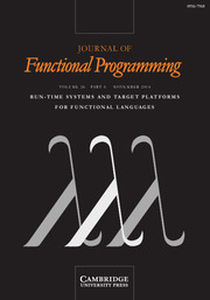No CrossRef data available.
Article contents
CUFP'13 scribe's report
Published online by Cambridge University Press: 16 March 2015
Extract
Core share and HTML view are not available for this content. However, as you have access to this content, a full PDF is available via the ‘Save PDF’ action button.
The Commercial Users of Functional Programming workshop (CUFP) is an annual workshop held in association with the International Conference on Functional Programming (ICFP). The aim of the CUFP workshops is to publicize the use of functional programming in commercial ventures. Its motto is “functional programming as a means, not an end.
- Type
- Commercial Uses
- Information
- Copyright
- Copyright © Cambridge University Press 2015
References
Chandra, T. D., Griesemer, R. & Redstone, J. (2007) Paxos made live: An engineering perspective. In Proceedings of the 26th Annual Symposium on Principles of Distributed Computing. ACM, pp. 398–407.Google Scholar
Charles River Analytics (2014) Figaro. Available at: https://www.cra.com/commercial-solutions/probabilistic-modeling-services.asp.Google Scholar
Christensen, B. & Husain, J. (2013. Reactive programming in the Netflix API with RxJava. Available at: http://techblog.netflix.com/2013/02/rxjava-netflix-api.html.Google Scholar
Claessen, K. & Hughes, J. (2011) Quickcheck: A lightweight tool for random testing of Haskell programs. In Proceedings of the International Conference on Functional Programming, vol. 46 (4), pp. 53–64.Google Scholar
Compall, S. 2014 A users guide to Ermine. Available at: https://launchpad.net/ermine-user-guide.Google Scholar
Epstein, J., Black, A. P. & Peyton-Jones, S. (2011) Towards Haskell in the cloud. In Proceedings of the Haskell Symposium, vol. 46. ACM.Google Scholar
Google Inc. (2014). Protocol buffers. Available at: https://developers.google.com/protocol-buffers/.Google Scholar
Herington, D. (2014) HUnit 1.0 user's guide. Available at: http://www.haskell.org/haskellwiki/HUnit_1.0_User's_Guide.Google Scholar
Lamport, L. (1998) The part-time parliament. ACM Trans. Comput. Syst. (TOCS) 16 (2), 133–169.CrossRefGoogle Scholar
Letourneau, P.-J. (2013) Mathematica gets big data with HadoopLink. Available at: http://blog.wolfram.com/2013/07/31/mathematica-gets-bigdata-with-hadooplink/.Google Scholar
Madhavapeddy, A., Minsky, Y. & Eriksen, M. (2012) CUFP 2011 workshop report. J. Funct. Program. 22 (1), 1–8.CrossRefGoogle Scholar
Mitchell, N. (2014) HLint manual. Available at: http://community.haskell.org/~ndm/darcs/hlint/hlint.htm.Google Scholar
Pfeffer, A. (2009) Figaro: An object-oriented probabilistic programming language. Charles River Analytics Technical Report, 137.Google Scholar
Siek, J. G. & Taha, W. (2006) Gradual typing for functional languages. Scheme and Functional Programming Workshop, University of Chicago, Technical Report TR-2006-06, pp. 81–92.Google Scholar
Slee, M., Agarwal, A. & Kwiatkowski, M. (2007) Thrift: Scalable cross-language services implementation. Available at: http://thrift.apache.org/static/files/thrift-20070401.pdf.Google Scholar
Snoyman, M. (2012) Developing Web Applications with Haskell and Yesod. O'Reilly Media, Inc.Google Scholar
Sperber, M. & Madhavapeddy, A. (2013) Commercial users of functional programming workshop report. J. Funct. Program. 23 (11), 701–712.CrossRefGoogle Scholar
Tobin-Hochstadt, S. & Felleisen, M. (2006) Interlanguage migration: From scripts to programs. (Companion Dynamic Languages Symposium), pp. 964–974.CrossRefGoogle Scholar
Typesafe Inc. (2014a) Akka documentation: Release 2.0.2. Available at: http://doc.akka.io/docs/akka/2.0.2/Akka.pdf.Google Scholar
Verlaguet, J. & Menghrajani, A. (2014) Hack: A New Programming Language for HHVM. Available at: https://code.facebook.com/posts/264544830379293/hack-a-new-programming-language-for-hhvm/.Google Scholar
Vouillon, J. & Balat, V. (2014) From bytecode to JavaScript: The Js_of_ocaml compiler. Softw. Pract. Exp. 44 (8), 951–972.CrossRefGoogle Scholar



Discussions
No Discussions have been published for this article.